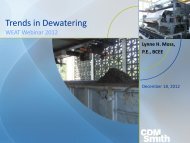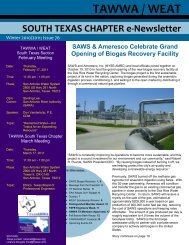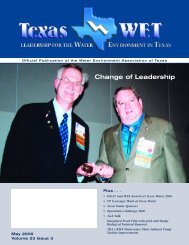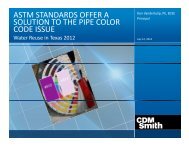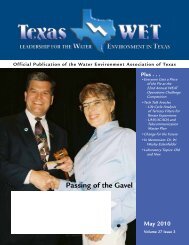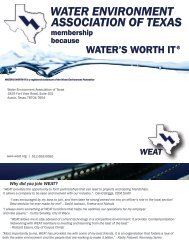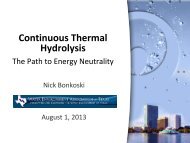Hexavalent Chromium in Drinking Water
Hexavalent Chromium in Drinking Water
Hexavalent Chromium in Drinking Water
You also want an ePaper? Increase the reach of your titles
YUMPU automatically turns print PDFs into web optimized ePapers that Google loves.
<strong>Hexavalent</strong> <strong>Chromium</strong> <strong>in</strong><br />
Dr<strong>in</strong>k<strong>in</strong>g <strong>Water</strong><br />
myths and mysteries resolved<br />
USEPA Method 218.7<br />
Presented by<br />
Jay Gandhi, PhD – Metrohm USA<br />
Johnson Mathew – USEPA Region 6 (Houston)<br />
E. Pr<strong>in</strong>ce – U of H – Clearlake (Houston)<br />
WEAT 2012 - Aust<strong>in</strong> TX (Dr. Jay Gandhi) 1
WEAT 2012 - Aust<strong>in</strong> TX (Dr. Jay Gandhi) 2
Disclaimer – work<strong>in</strong>g with USEPA<br />
*Reference here<strong>in</strong> to any specific commercial products or nonprofit<br />
organization, process, or service by trade name, trademark,<br />
manufacturer, or other-wise, does not necessarily constitute or<br />
imply its endorsement, recommendation, or favor<strong>in</strong>g by the<br />
United States Government. The views and op<strong>in</strong>ions of authors<br />
expressed here<strong>in</strong> do not necessarily state or reflect those of the<br />
United States Government and shall not be used for advertis<strong>in</strong>g<br />
or product endorsement purposes.<br />
WEAT 2012 - Aust<strong>in</strong> TX (Dr. Jay Gandhi) 3
What we’ll we ll cover today<br />
• USEPA method for <strong>Chromium</strong>-6 Analysis<br />
– A Collaborative approach with USEPA<br />
• Pr<strong>in</strong>ciple of the method<br />
• <strong>Hexavalent</strong> <strong>Chromium</strong> Analysis<br />
• USEPA Method 218.7….. Updated from 218.6<br />
• Sample Preservation Study<br />
• Various Buffer Chemistries<br />
• Data for Sample Preservation study<br />
• Data from common Dr<strong>in</strong>k<strong>in</strong>g water matrix<br />
• Summary<br />
WEAT 2012 - Aust<strong>in</strong> TX (Dr. Jay Gandhi) 4
Background<br />
• Environmental Work<strong>in</strong>g Group Study<br />
• www.ewg.org – December 2010 report (pdf)<br />
• 31 cities <strong>in</strong> US – affected by Cr +6 <strong>in</strong> dr<strong>in</strong>k<strong>in</strong>g water<br />
• Watch group studies <strong>in</strong>dicate that 89% of US water<br />
utilities (water supply) have Cr +6 <strong>in</strong> their DW<br />
• News media picked up this report<br />
http://thechart.blogs.cnn.com/2010/12/20/carc<strong>in</strong>ogenfound-<strong>in</strong>-31-of-35-cities-water-supply/<br />
• EPA’s response to <strong>in</strong>vestigation<br />
WEAT 2012 - Aust<strong>in</strong> TX (Dr. Jay Gandhi) 5
Background<br />
• Cr +6 & human health?<br />
• “This study clearly identifies a l<strong>in</strong>ear trend of <strong>in</strong>creas<strong>in</strong>g risk of<br />
lung cancer mortality with <strong>in</strong>creas<strong>in</strong>g cumulative exposure to<br />
water soluble hexavalent chromium.”<br />
Park, et al , Risk Analysis, Vol 24, 2004<br />
• Debate over Level (concentration exposure) vs Risk<br />
• Is all <strong>Chromium</strong> bad for our health?<br />
• <strong>Chromium</strong> <strong>in</strong> oxidation state +3 is an essential<br />
micronutrient to metabolize fat <strong>in</strong>to energy<br />
• <strong>Chromium</strong> <strong>in</strong> oxidation state +6 is a carc<strong>in</strong>ogen<br />
• No EPA def<strong>in</strong>ed limit for Cr +6 …MCL -100 ppb for Total Cr<br />
WEAT 2012 - Aust<strong>in</strong> TX (Dr. Jay Gandhi) 6
Current USEPA Methods<br />
For Dr<strong>in</strong>k<strong>in</strong>g <strong>Water</strong>:<br />
USEPA Method 218.6<br />
Updated <strong>in</strong> December 2011 to USEPA method 218.7<br />
WEAT 2012 - Aust<strong>in</strong> TX (Dr. Jay Gandhi) 7
Pr<strong>in</strong>ciple of the Method<br />
Cr (VI) -<br />
Chromate<br />
CrO -2<br />
4<br />
Cr -2<br />
2O7 pH = 9.5<br />
or higher<br />
In post column reactor<br />
1N H 2 SO 4 + Diphenyl<br />
Carbazide (DPC)<br />
Cr (VI)<br />
forms<br />
complex <strong>in</strong><br />
presence of<br />
excess H +<br />
to form<br />
Magenta color<br />
WEAT 2012 - Aust<strong>in</strong> TX (Dr. Jay Gandhi) 8
Typical <strong>in</strong>strument setup (Dos<strong>in</strong>o for PCR)<br />
WEAT 2012 - Aust<strong>in</strong> TX (Dr. Jay Gandhi) 9
Alternate <strong>in</strong>strument setup (HP pump for PCR)<br />
Auto sampler IC System PCR/VIS (DPC)<br />
WEAT 2012 - Aust<strong>in</strong> TX (Dr. Jay Gandhi) 10
<strong>Chromium</strong> System at work (USEPA, C<strong>in</strong>c<strong>in</strong>nati OH)<br />
WEAT 2012 - Aust<strong>in</strong> TX (Dr. Jay Gandhi) 11
USEPA Method 218.7 – Option 1<br />
• Current app notes (AW US6-0134, US6-0152 and CH6-1049)<br />
• Metrohm:<br />
• Column: ASUPP5 – 150 (4mm ID Column)<br />
• Eluent: 12.8 mM Na2CO3 + 4.0mM NaHCO3 + 2.5mM<br />
Amm.Sulfate<br />
• Flow rate: 0.7 mL/m<strong>in</strong><br />
• PCR: Diphenyl Carbazide<br />
• PCR flow: 0.24 mL/m<strong>in</strong><br />
• Sample loop: 2 mL<br />
• Reaction coil – 375uL Volume<br />
(optimized for correct reaction ratio)<br />
• Vis Detector: 530nm<br />
WEAT 2012 - Aust<strong>in</strong> TX (Dr. Jay Gandhi) 12
USEPA Method 218.7 – Option 2<br />
• Metrohm:<br />
• Column: ASUPP10 – 100 (2mm ID column)<br />
• Eluent: 15g/L Amm.Sulfate + 6.5mL/L<br />
Amm.Hydroxide<br />
• Flow rate: 0.45 mL/m<strong>in</strong><br />
• PCR: Diphenyl Carbazide<br />
• PCR flow: 0.22 mL/m<strong>in</strong><br />
• Sample loop: 1 mL<br />
• Reaction coil – 375uL Volume<br />
(optimized for correct reaction ratio)<br />
• Vis Detector: 530nm<br />
WEAT 2012 - Aust<strong>in</strong> TX (Dr. Jay Gandhi) 13
Chromatogram<br />
mAU<br />
6.0<br />
4.0<br />
2.0<br />
0.0<br />
Chrom-6<br />
0.0 1.0 2.0 3.0 4.0 5.0 6.0 m<strong>in</strong><br />
Column: ASUPP 10-250<br />
Loop size 2000 microliters<br />
Eluent: 15g/L (NH4)2SO4 + 6.5ml/L NH4OH<br />
Flow rate: 0.8mls per m<strong>in</strong>ute<br />
PCR: DPC reagent<br />
PCR flow: 0.4mls per m<strong>in</strong>ute<br />
UV detection at 530nM<br />
(mAU) x m<strong>in</strong><br />
6.0<br />
5.0<br />
4.0<br />
3.0<br />
2.0<br />
1.0<br />
0.0<br />
0.0 1.0 2.0 3.0 4.0 5.0 ppb<br />
0.025 ppb <strong>in</strong> DW Calibration Range<br />
0.025 – 5.00 ppb<br />
WEAT 2012 - Aust<strong>in</strong> TX (Dr. Jay Gandhi) 14
MDL Study Data<br />
MDL study (0.025ppb and 0.050ppb)<br />
Chrom‐6<br />
Chrom‐6<br />
parts per billion<br />
parts per billion<br />
MDL‐1 day 1 0.026 MDL‐2‐Day 1 0.051<br />
MDL‐1 day 1 0.028 MDL‐2‐Day 1 0.044<br />
MDL‐1 day 2 0.029 MDL‐2‐Day 2 0.040<br />
MDL‐1 day 2 0.028 MDL‐2‐Day 2 0.046<br />
MDL‐1 day 2 0.031 MDL‐2‐Day 2 0.055<br />
MDL‐1 day 3 0.030 MDL‐2‐Day 3 0.051<br />
MDL‐1 day 3 0.024 MDL‐2‐Day 3 0.047<br />
average 0.028 average 0.048<br />
std dev 0.0024 std dev 0.005<br />
calculated MDL 0.007 calculated MDL 0.016<br />
*MDL = 3.14 x SD *MDL = 3.14 x SD<br />
WEAT 2012 - Aust<strong>in</strong> TX (Dr. Jay Gandhi) 15
MRL Study Data<br />
MRL Data<br />
analysis‐1<br />
Chrom‐6, ppb<br />
0.026<br />
analysis‐2 0.028<br />
analysis‐3 0.031<br />
analysis‐4 0.026<br />
analysis‐5 0.027<br />
analysis‐6 0.028<br />
analysis‐7 0.029<br />
Mean 0.0279<br />
std.Dev 0.0018<br />
HPPIR True Concentration<br />
0.0070<br />
0.025<br />
Upper HP PIR<br />
Lower HP PIR<br />
139.5311638<br />
83.32597905<br />
Must be less than 150<br />
Must be greater than 50<br />
WEAT 2012 - Aust<strong>in</strong> TX (Dr. Jay Gandhi) 16
Sample<br />
Preservation<br />
Study<br />
WEAT 2012 - Aust<strong>in</strong> TX (Dr. Jay Gandhi) 17
Work at US EPA to validate new method<br />
• C<strong>in</strong>c<strong>in</strong>nati & Region 6 laboratories<br />
• Sample preservation study data<br />
• Various preservatives were studied<br />
•NaHCO3/Na2CO3 •(NH4) 2SO4/NH4OH •NaHCO3/Na2CO3 + amm. sulfate<br />
• Borate buffer<br />
•NaOH + Na2CO3 WEAT 2012 - Aust<strong>in</strong> TX (Dr. Jay Gandhi) 18
Sample Preservation Buffer Studied<br />
Buffer Chemical Composition<br />
Initial<br />
measured pH<br />
A 2 mM Na 2 CO 3 + 10 mM NaOH <strong>in</strong> 1000 mL 12.0<br />
B 1.25 mM Na 2 CO 3 + 1.25 mM NaHCO 3 <strong>in</strong> 1000 mL 10.2<br />
C 0.4 g (NH 4 ) 2 SO 4 + 0.65 mL NH 4 OH <strong>in</strong> 1000mL 10.0<br />
D<br />
E<br />
In each matrix<br />
1ppb Cr +6<br />
1.25 mM Na 2 CO 3 + 1.25 mM NaHCO 3 + 0.15 g/L<br />
(NH 4 ) 2 SO 4 <strong>in</strong> 1000 mL<br />
5 mM NaHCO 3 + 10 mM Na Tetra Borate <strong>in</strong> 1000<br />
+6 &<br />
mL<br />
& 1ppb Cr +6 + 1ppb Cr +3<br />
9.25<br />
9.10<br />
WEAT 2012 - Aust<strong>in</strong> TX (Dr. Jay Gandhi) 19
Buffer Study Data<br />
Buffer B - pH ~ 10.2<br />
1.25 mM Na 2 CO 3 + 1.25 mM NaHCO 3<br />
Buffer A - pH ~ 12.0<br />
2 mM Na 2 CO 3 + 10 mM NaOH<br />
WEAT 2012 - Aust<strong>in</strong> TX (Dr. Jay Gandhi) 20
Buffer Study Data<br />
Buffer D - pH ~ 9.7<br />
1.25 mM Na 2 CO 3 + 1.25 mM NaHCO 3<br />
+ 0.15 g/L (NH 4 ) 2 SO 4<br />
Buffer C - pH ~ 9.0<br />
0.4 g (NH 4 ) 2 SO 4 + 0.65 mL NH 4 OH<br />
WEAT 2012 - Aust<strong>in</strong> TX (Dr. Jay Gandhi) 21
Buffer Study Data<br />
Buffer E - pH ~ 9.5<br />
5 mM NaHCO 3 + 10 mM Na Tetra Borate<br />
WEAT 2012 - Aust<strong>in</strong> TX (Dr. Jay Gandhi) 22
Other Ions of Dr<strong>in</strong>k<strong>in</strong>g water<br />
• Chloride (100ppm), Sulfate (150ppm) and<br />
Total Hardness as CaCO3 (450ppm)<br />
WEAT 2012 - Aust<strong>in</strong> TX (Dr. Jay Gandhi) 23
Reduc<strong>in</strong>g Agents<br />
• Fe +2 and Fe +3 (10ppm), Mn +2 (5ppm) and Humic<br />
Acid (Total carbon 25ppm)<br />
WEAT 2012 - Aust<strong>in</strong> TX (Dr. Jay Gandhi) 24
Reduc<strong>in</strong>g Agent – Only Humic Acid<br />
• Humic Acid (Total carbon 25ppm)<br />
WEAT 2012 - Aust<strong>in</strong> TX (Dr. Jay Gandhi) 25
Summary<br />
• Sample preservation study concluded that<br />
• pH greater than 9.5 is preferred for sample preservation<br />
• For DW, due to Chlor<strong>in</strong>e as dis<strong>in</strong>fectant, ammonium salt<br />
added to sample preservation helps <strong>Chromium</strong> species<br />
<strong>in</strong>ter-conversion issue<br />
• Two buffers that worked best <strong>in</strong> this study are<br />
• Ammonium Sulfate + Ammonium Hydroxide<br />
• Sodium Carbonate + Sodium Bicarbonate + Ammonium Sulfate<br />
• In Collaboration with USEPA – Metrohm developed simple yet<br />
robust method for <strong>Hexavalent</strong> <strong>Chromium</strong> <strong>in</strong> dr<strong>in</strong>k<strong>in</strong>g water<br />
• With modern Metrohm IC <strong>in</strong>strumentation trace level<br />
detection of <strong>Chromium</strong>-6 is possible<br />
• Metrohm Also has onl<strong>in</strong>e analyzers for cont<strong>in</strong>uous<br />
monitor<strong>in</strong>g of <strong>Hexavalent</strong> chromium<br />
WEAT 2012 - Aust<strong>in</strong> TX (Dr. Jay Gandhi)<br />
26
Acknowledgements<br />
• Mr. Johnson Mathew – USEPA Region – 6<br />
• Mr. David Neliegh – USEPA Region –6<br />
• Dr. Melv<strong>in</strong> Ritter – USEPA Region –6<br />
• Ms. Marvyln Humphrey – USEPA Region –6<br />
• Dr. David Munch – Retired USEPA –ODW/OGW<br />
• Dr. Steve Wendelken – USEPA –ODW/OGW<br />
• Mr. Alan Zaffiro - Shaw Group/USEPA – C<strong>in</strong>c<strong>in</strong>nati OH<br />
• Metrohm AG applications team<br />
especially, Dr. Kat<strong>in</strong>ka Ruth and Dr. Andrea Willie<br />
• Dr. Hari Narayanan – Metrohm USA Applications Lab<br />
• Dr. Chunlong Zhang– University of Houston - Clearlake<br />
WEAT 2012 - Aust<strong>in</strong> TX (Dr. Jay Gandhi)<br />
27
Thank you for listen<strong>in</strong>g<br />
The many faces of Metrohm Applications<br />
Let us help you become the expert <strong>in</strong> your lab!<br />
WEAT 2012 - Aust<strong>in</strong> TX (Dr. Jay Gandhi) 28





